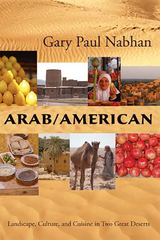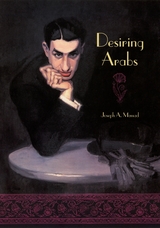3 books about Civilization, Arab

Arab/American
Landscape, Culture, and Cuisine in Two Great Deserts
Gary Paul Nabhan
University of Arizona Press, 2008
The landscapes, cultures, and cuisines of deserts in the Middle East and North America have commonalities that have seldom been explored by scientists—and have hardly been celebrated by society at large. Sonoran Desert ecologist Gary Nabhan grew up around Arab grandparents, aunts, uncles, and cousins in a family that has been emigrating to the United States and Mexico from Lebanon for more than a century, and he himself frequently travels to the deserts of the Middle East. In an era when some Arabs and Americans have markedly distanced themselves from one another, Nabhan has been prompted to explore their common ground, historically, ecologically, linguistically, and gastronomically. Arab/American is not merely an exploration of his own multicultural roots but also a revelation of the deep cultural linkages between the inhabitants of two of the world’s great desert regions. Here, in beautifully crafted essays, Nabhan explores how these seemingly disparate cultures are bound to each other in ways we would never imagine. With an extraordinary ear for language and a truly adventurous palate, Nabhan uncovers surprising convergences between the landscape ecology, ethnogeography, agriculture, and cuisines of the Middle East and the binational Desert Southwest. There are the words and expressions that have moved slowly westward from Syria to Spain and to the New World to become incorporated—faintly but recognizably—into the language of the people of the U.S.–Mexico borderlands. And there are the flavors—piquant mixtures of herbs and spices—that have crept silently across the globe and into our kitchens without our knowing where they came from or how they got here. And there is much, much more. We also learn of others whose work historically spanned these deserts, from Hadji Ali (“Hi Jolly”), the first Moslem Arab to bring camels to America, to Robert Forbes, an Arizonan who explored the desert oases of the Sahara. These men crossed not only oceans but political and cultural barriers as well. We are, we recognize, builders of walls and borders, but with all the talk of “homeland” today, Nabhan reminds us that, quite often, borders are simply lines drawn in the sand.
[more]

Desiring Arabs
Joseph A. Massad
University of Chicago Press, 2007
Sexual desire has long played a key role in Western judgments about the value of Arab civilization. In the past, Westerners viewed the Arab world as licentious, and Western intolerance of sex led them to brand Arabs as decadent; but as Western society became more sexually open, the supposedly prudish Arabs soon became viewed as backward. Rather than focusing exclusively on how these views developed in the West, in Desiring Arabs Joseph A. Massad reveals the history of how Arabs represented their own sexual desires. To this aim, he assembles a massive and diverse compendium of Arabic writing from the nineteenth century to the present in order to chart the changes in Arab sexual attitudes and their links to Arab notions of cultural heritage and civilization.
A work of impressive scope and erudition, Massad’s chronicle of both the history and modern permutations of the debate over representations of sexual desires and practices in the Arab world is a crucial addition to our understanding of a frequently oversimplified and vilified culture.
“A pioneering work on a very timely yet frustratingly neglected topic. . . . I know of no other study that can even begin to compare with the detail and scope of [this] work.”—Khaled El-Rouayheb, Middle East Report
“In Desiring Arabs, [Edward] Said’s disciple Joseph A. Massad corroborates his mentor’s thesis that orientalist writing was racist and dehumanizing. . . . [Massad] brilliantly goes on to trace the legacy of this racist, internalized, orientalist discourse up to the present.”—Financial Times
[more]

The End of Middle East History and Other Conjectures
Richard W. Bulliet
Harvard University Press, 2020
The End of Middle East History and Other Conjectures is an unapologetic collection of imaginative essays from thought-provoking Middle East scholar Richard W. Bulliet. Not your ordinary think pieces, this volume collects for the first time Bulliet’s Big Bang–Big Crunch theory of Islamic history and his illuminating conception of the “Muslim South.” Speculations range from future political events to counterfactual histories of how reversal of the outcome of a 1529 battle might have profoundly altered history. After fifty years of posing and answering daring historical questions, Bulliet happily tackles an array of conjectures on subjects as diverse as the origin of civilization, the end of Middle East history, and future interpretations of the twentieth century.
[more]
READERS
Browse our collection.
PUBLISHERS
See BiblioVault's publisher services.
STUDENT SERVICES
Files for college accessibility offices.
UChicago Accessibility Resources
home | accessibility | search | about | contact us
BiblioVault ® 2001 - 2024
The University of Chicago Press









